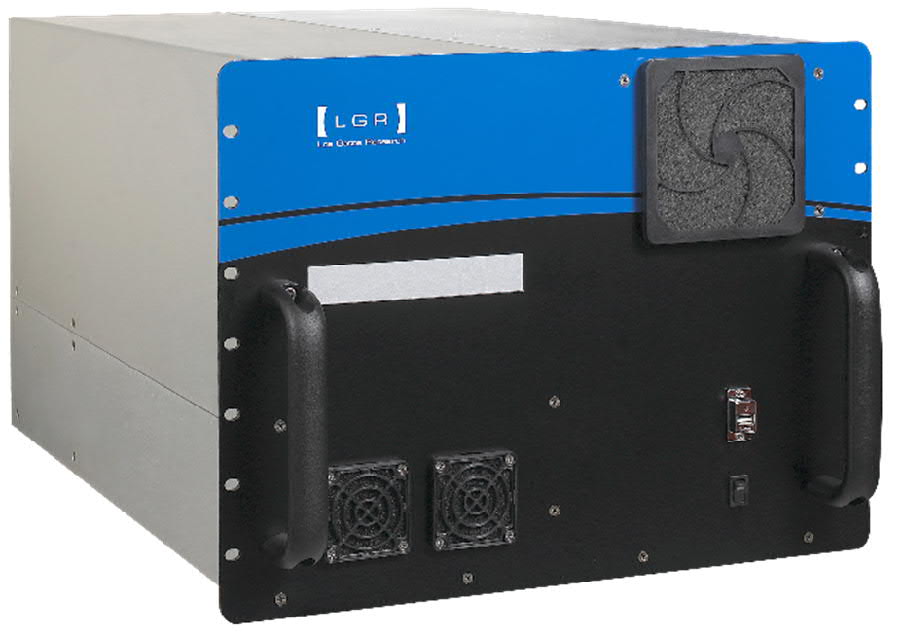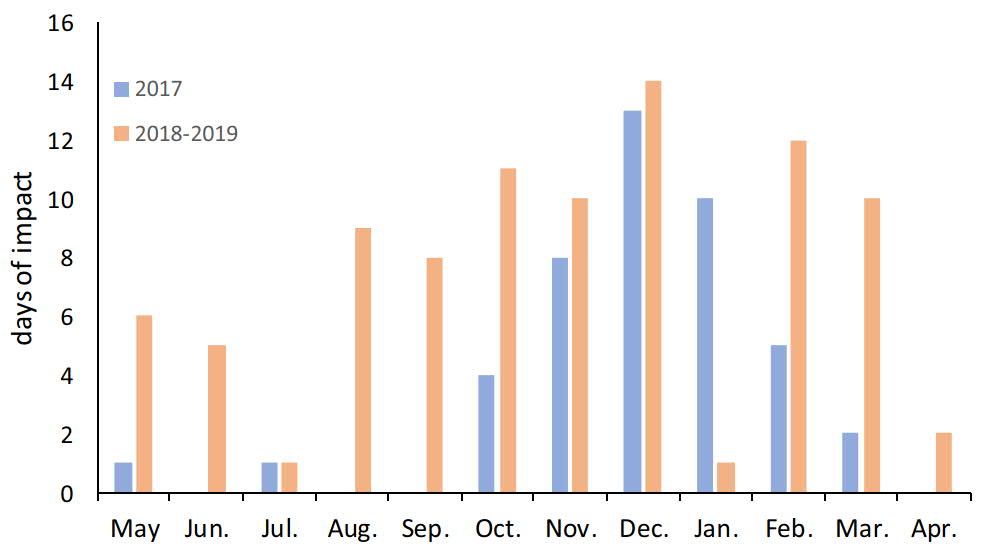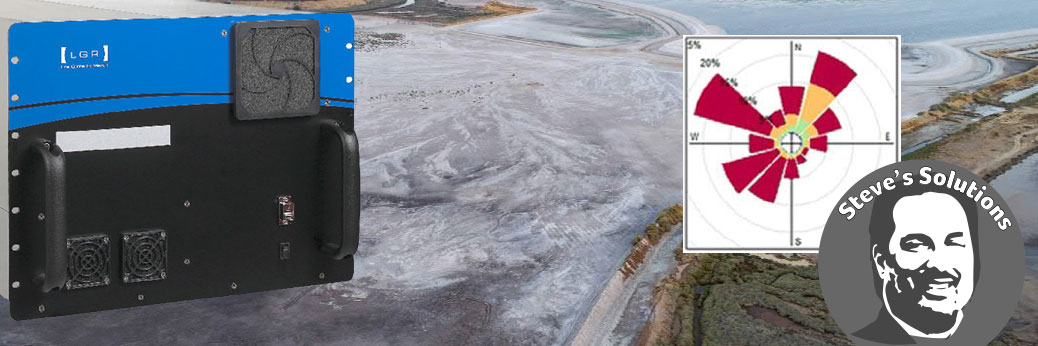Hydrogen fluoride (HF) is a highly corrosive acid gas, and an irritant for the respiratory track. It is one of the most toxic gaseous compounds in air, and accounts for 75% of the global fluorine flux. Because of its toxicity and harmful effects, the World Health Organization recommends that the
concentration does not exceed 1.0 μg/m3 to protect crops and cattle. However there is no European or American legislation regarding HF concentration in ambient air, and few studies on that topic have been performed due to the difficulty of achieving reliable measurements of HF. Measurements are commonly based on HF adsorption in impregnated cartridge filters to obtain an average concentration, but HF is chemically inert at low concentrations and this passive sampling methodology usually underestimates the high concentration excursions that last a few seconds or
minutes.
One of the main anthropogenic HF sources is industrial activity, specifically the phosphate fertilizer industry which is essential to maintain the levels of farming production in developed countries, and even more when developing countries reach such production levels. Mined phosphate rock is first converted into phosphoric acid, which serves as the basis of phosphoric fertilizer and animal feed product. This is most requently carried out via a wet process, in which dried phosphate rock is combined with sulfuric acid in a reaction yielding phosphoric acid and calcium sulfate -also called phosphogypsum (PG). This unwanted by-product of fertilizer manufacturing is mainly composed by gypsum and other minor small solid phases (e.g. phosphate, fluoride, feldspar, organic matter). Although gypsum is a widely used material in the construction industry, PG is usually not used, and 85% of produced PG is stored indefinitely in stockpiles, because of its weak radioactivity. For every ton of phosphoric acid produced, around 5 tons of PG are generated. Overall, between 100 and 280 million tons of PG are produced annually, making this a substantial source of industrial waste, especially given in the context that phosphatic fertilizer production is constantly on the rise in an effort to feed the exploding world population.
[WD_Button id=2788] [WD_Button id=2792]
In recently published article “Hydrogen fluoride concentrations in ambient air of an urban area based on the emissions of a major phosphogypsum deposit (SW, Europe)”, a group of scientists from the University of Huelva (Spain) present their work on real-time assessment of the contribution of HF emissions from a PG deposit to atmospheric pollution. The study describes measurements of HF concentrations with different sampling schemes in an urban area near a major PG stack located on the side of sandy river bank, north of Huelva city. HF concentrations were measured by passive cartridge sampling during summer and winter months from 2014 to 2017. High-resolution sampling was also performed during 2017 and 2017–2018 using an LGR-ICOS GLA331-HF Analyser.


The red dot and red square represent the monitoring stations where the LGR-ICOS HF analyser was located (Torres-Sanchézet al. )
The study zone for passive cartridges was divided into the PG evaporation pond and its surroundings, the city, and a rural monitoring station 54 km from the city. Winter and summer experiments were performed from 2014 to 2017 and a total of 180 samples was analysed. Each passive cartridge was sampled for two weeks. An eluent solution was then added to each sample
tube and stirred for 2 minutes. After stabilization, the solution was analysed by ion chromatography.

For high-resolution real-time measurements, the LGR-ICOS HF Analyser was selected as it provides fast (laser response time <20 ms), sensitive and accurate measurements with minimal drift and no need for exhaustive calibration. Furthermore, the selectivity of the patented LGR-ICOS technique minimizes sensitivity to cross-interferences from background gases. The HF Analyser was first located in the Campus del Carmen monitoring station of the air quality network of Andalusia throughout year 2017, and subsequently moved to the Los Rosales monitoring station (0.5 km from the PG deposit) from May 2018 to April 2019. The instrument was set up with a Teflon inlet of 6.35 mm diameter and a 3 L/min flow rate. Measurements were obtained every 100 seconds.

The data on fugitive HF emissions from the PG deposit obtained with either passive cartridge sampling or high-resolution / real-time LGR-ICOS analysis were averaged over one hour and paired with meteorological data provided by the Agencia Estatal de Meteorología of the Spanish Government to perform statistical analyses.
The detection limit of passive cartridges is 7 mg/m3 (for 24 hours exposure), making them much less sensitive than the LGR-ICOS HF Analyser (detection limit 0.01 mg/m3). The authors therefore used the passive cartridge results collected during 3 years at different locations around the PG site to perform analysis of the spatial variations of HF concentration, and they leveraged the sensitivity and speed of the high-resolution LGR-ICOS measurements to perform temporal trends and also assess population’s exposure to pollution. Applying a 0.1 mg/m3 threshold to identify events where the HF concentration had an impact on urban air quality, they were able to quantify the number of days with pollution impact during the LGR-ICOS sampling period.

Combined analysis of HF urban impacts with polar and meteorological data confirmed that the impacts were related to the SSW-E wind directions, coinciding with the location of the PG deposit. The winter season showed the highest number of days with recorded impacts; this is expected to be caused by the fact that the local rainy season starts in October, dissolving the layered salts that generate brines in the PG pond, and therefore releasing F- ions and providing higher HF availability.
The cold season impacts reached 0.3 mg/m3 in 2017 and 2018–2019 and occurred mostly at night and in early morning, associated to temperatures <20°C and relative humidity >60% leading to fog. The HF impacts recorded in the warm season were more concentrated than those in winter, greater than 0.5 mg/m3, and occasionally 1 mg/m3. Warm season impacts were strongest at noon and directly associated to the evaporation of brines from the PG pond coinciding with temperatures >20°C and relative humidity <30%.
On the basis of the LGR-ICOS measurements and considering the average volume of air inhaled by a resting adult (0.54 m3/h), the authors were able to estimate annual intakes of fluoride through HF inhalation for Huelva citizens of 4.2 g (2017) and 2.2 g (2018–2019) respectively. A daily intake of 0.95 mg was even recorded during the highest impact of 2017. Those observations suggest that chronic exposure to the concentrations measured in the study could be one of the environmental causes of the high asthma incidence in the city of Huelva -especially for children and teenagers- compared to the rest of the country. Overall, the results of this study confirm that restoration of the PG deposit is highly desirable to prevent HF emissions.
This information is adapted from an ABB LGR-ICOS environmental Newsletter #4, 2020.
Link to research publication: Hydrogen fluoride concentrations in ambient air of an urban area based on the emissions of a major phosphogypsum deposit (SW, Europe)
For More information
Steve’s Solutions
To view gas analyzers in action, visit the Steve’s Solutions articles featuring these instruments.
 | Measuring Urban Impact of Acidic Emissions from a Fertilizer Residuals Landfill |
 | Recent findings on methane emissions by trees pose new challenges to the environmental community. |
For More information
ABB Measurement & Analytics Website
Los Gatos Research Website

Contact Us Online Form
Phone: 916-897-2441
Email: [email protected]

